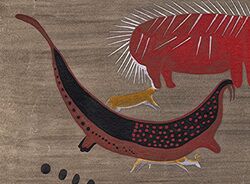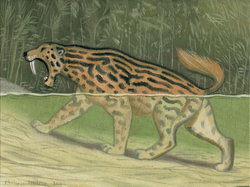Water lions or jungle walruses are river monsters reported, under a variety of names, from several countries in Central Africa. The majority of sightings have been reported from the Central African Republic and southern Chad, but also as far afield as Angola in the southwest, Mali in the northwest, and Kenya in the east.
Description[]
Water lions are usually described as semi-aquatic hairy animals with large tusks or fangs, which kill but do not eat hippopotamuses. A couple are described as being scaly, possibly due to wet, shiny fur. Another recurring feature of water lions is their savage nature and man-eating habits: if the various water lions are indeed a single animal, it must have a higher body count than any other cryptid.
The most famous and widely-seen of the water lions is the mourou-ngou ("water leopard"), reported from dozens of rivers in the Central African Republic and Chad, especially the Bamingui. It is described as an 8- to 12-foot animal the shape of a leopard, with striped or dappled fur, a hairy tail, and long fangs. The mourou-ngou is said to be a man-eater, and in 1911 one allegedly killed a French tirailleur during a crossing of the confluence of the Bamingui and Koukourou Rivers.
Other reports generally conform to the description of a short-tailed, hippo-killing, often cat-like animal with tusks. In Angola's Upper Cuango and Cuanza Rivers the animal is known as the coje ya menia ("water lion"); in Chad's Chad's Ouham River as the dilali ("water lion"); in the Central African Republic's Vovodo River as the ngoroli ("water lion"); and in the Democratic Republic of the Congo's Lualaba River as the nzefu-loï ("water elephant"). Other water lions include the mamaïmé, ze-ti-ngu, ntambue ya maï, ntambo wa luy, and simba ya mail. It has also been suggested that the nyokodoing of South Sudan and the dingonek of far western Kenya may be water lions. Very similar but unnamed animals have been reported from the Ituri Rainforest, Mali, and Lake Bangweulu.
Evidence[]
Other than eyewitness testimony, evidence includes a number of sightings and photographs of hippopotamuses with large, unusual wounds which do not seem to have been made by any known animal; and an ancient cave painting of a fanged, four-legged animal with a small head found at Brakfontein Ridge, Free State Province, South Africa. Explorer Hans Schomburgk acquired a carving of the Zambian "water leopard". The powerful rumbling roars of water lions are also supposedly heard sometimes, and the headman of a village on the Bangoran River supposedly owned a mourou-ngou skull.

The "jungle walrus" of Brakfontein Ridge.
Explanations[]
German mammalogist Ingo Krumbiegel first suggested that these animals may be living sabre-toothed cats in 1947, and this idea was expanded by cryptozoologist Bernard Heuvelmans. Heuvelmans theorised that sabre-toothed cats could have become aquatic animals in order to avoid competition with other big cats like lions and leopards, and to allow them to eat meat which has been putrefied in water. Their fangs, he suggested, could be used to dig up shellfish and turtles from riverbeds, or even to gain a purchase on slippery riverbanks. Other suggestions include that they are giant dwarf African crocodiles, giant monitor lizards, otters, African wildcats, or Water Elephants with tusks.
See also[]
Another possible sabre-toothed cat reported from Chad and the Central African republic is the tigre de montagne (also called the coq-djingé, Ennedi Tiger, gassingrâm, and hadjel). Though this has often been equated with the water lion, it would be a very different animal, adapted for a life in the dry mountains. Water lions are also sometimes confused with the "Congo dragons", such as the Mokèlé-mbèmbé or the Emela-Ntouka. In a possible case of cryptozoological convergent evolution, amphibious felines with long fangs are also reported from South America, as are possible living sabre-toothed cats in the montane forests. There is also the Mishipeshu, or Underwater Panther, found in the American Great Lakes, another aquatic cat-like being.
Sources[]
- Heuvelmans, Bernard (1955) On the Track of Unknown Animals
- Shuker, Karl (1995) In Search of Prehistoric Survivors
- Eberhart, George (2002) Mysterious Creatures: A Guide to Cryptozoology
- Heuvelmans, Bernard & Rivera, Jean-Luc & Barloy, Jean-Jacques (2007) Les Félins Encore Inconnus d’Afrique
- Newton, Michael (2009) Hidden Animals: A Field Guide to Batsquatch, Chupacabra, and Other Elusive Creatures

